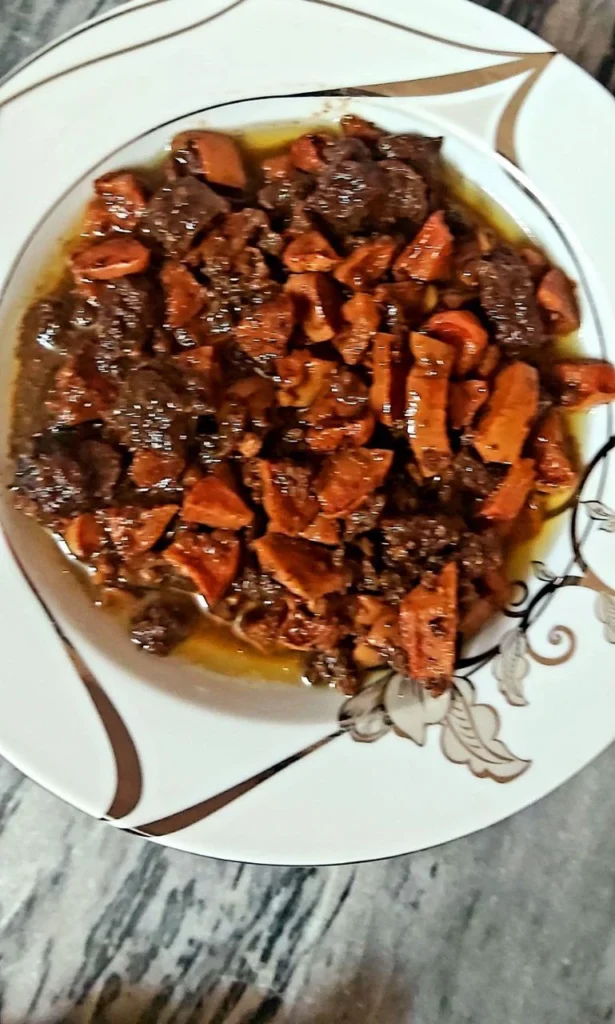Authentic Persian Quince Stew (Khoresh-e Beh) Recipe

If you’re craving a comforting dish that combines sweet, savory, and tangy flavors, Persian Quince Stew—known as Khoresh-e Beh—is a must-try. This traditional Iranian stew features tender lamb or beef, golden quince fruit, and warm spices simmered to perfection. It’s especially popular during fall when quinces are in season.
In this article, you’ll learn how to make khoresh-e beh from scratch, along with tips for sourcing quince in the U.S. and adapting the recipe to your taste.
🍐 What Is Quince?
Quince is a golden-yellow fruit that looks like a cross between an apple and a pear. It has a firm texture and a tart flavor when raw but becomes fragrant and slightly sweet when cooked. In Persian cuisine, quince is often used in stews and jams for its unique aroma and rich texture.
🌿 Ingredients for Khoresh-e Beh
Main Ingredients:
1 lb lamb or beef stew meat, cubed
2–3 ripe quinces, peeled and sliced
1 large onion, finely chopped
2 tbsp tomato paste
2 tbsp lemon juice or sour grape juice (optional for tang)
1 tbsp sugar (adjust to taste)
½ tsp ground cinnamon
½ tsp turmeric
Salt and pepper to taste
3 tbsp vegetable oil
3 cups water or broth
👨🍳 How to Make Persian Quince Stew
Step 1 – Sear the Meat:
Heat oil in a large pot over medium heat. Add chopped onion and sauté until golden. Add turmeric and then the meat. Brown on all sides.
Step 2 – Add Tomato Paste & Spices:
Stir in tomato paste, cinnamon, salt, and pepper. Let the mixture fry for a minute to enhance flavor.
Step 3 – Simmer:
Pour in water or broth to cover the meat. Cover and simmer for about 1.5 hours, or until the meat is tender.
Step 4 – Prepare Quince:
While the stew simmers, sauté the sliced quince in a little oil until lightly golden. This prevents the fruit from falling apart in the stew.
Step 5 – Combine & Cook:
Add the sautéed quince, sugar, and lemon juice to the stew. Cook uncovered for another 30 minutes until the quince is soft but not mushy.
🍽️ Serving Suggestions
Serve khoresh-e beh hot with steamed basmati rice, preferably with saffron for added aroma. It also pairs beautifully with fresh herbs and pickled vegetables (torshi).
🛒 Where to Buy Quince in the U.S.
Quince can be found at:
Middle Eastern or Persian grocery stores
Some farmers’ markets (especially in fall)
International sections of specialty grocery chains
If you can’t find quince, some people substitute with firm apples and a bit of lemon zest—but nothing truly replaces the fragrance of real quince.
💡 Tips for Best Results
Use ripe but firm quinces – overripe ones will turn mushy.
Balance sweet and sour – taste and adjust sugar and lemon as you go.
Make it ahead – flavors deepen overnight, making it even better the next day.
🇮🇷 A Taste of Persian Tradition
Khoresh-e beh is more than a meal—it’s a window into Iranian culinary culture. It’s warm, rich, and filled with the kind of flavor that makes you feel at home, even if you’re far away from one.
If you’re exploring Persian food for the first time, this dish is a wonderful place to start.
📌 Final Thoughts
Whether you’re Iranian-American longing for a nostalgic taste of home or a curious food lover in the U.S., Khoresh-e Beh brings seasonal comfort to your table with minimal effort. Add it to your fall cooking list—you won’t regret it.
